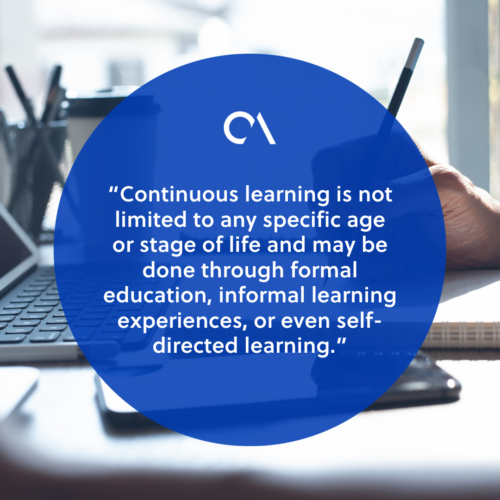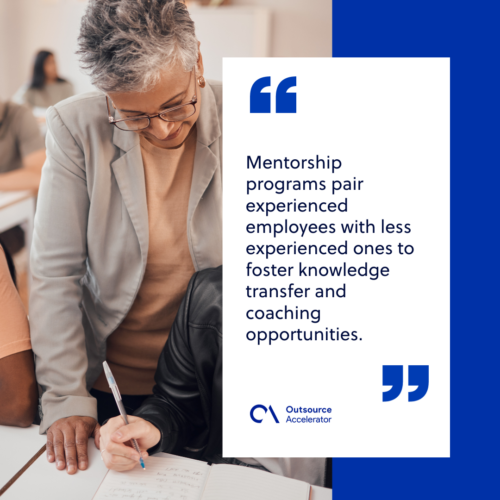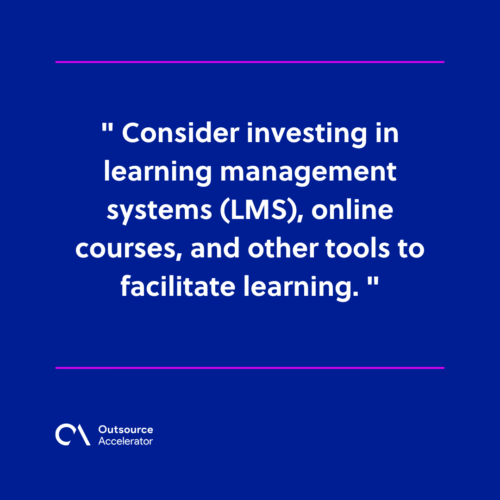Continuous learning: A key to success in the workplace

Continuous learning in the workplace has become increasingly important, practically becoming a lifeline for both individuals and organizations.
As technological advancements and market trends continue to reshape industries, the ability to adapt and acquire new skills has become imperative for staying competitive and relevant.
According to the 2023 LinkedIn Workplace Learning Report, 89% of Learning and Development (L&D) professionals agree that building employee skills today will help navigate the future of work.
This article digs into the pivotal concept of continuous learning, exploring its significance, benefits, and the strategies that empower employees and workplaces to thrive.
What is continuous learning?
Continuous learning is the process of acquiring knowledge, skills, and competencies on an ongoing basis throughout one’s life. This mentality is heavily encouraged within the workplace setting, where it’s sometimes called upskilling.
It involves actively seeking out opportunities to learn and grow. Continuous learning is not limited to any specific age or stage of life and may be done through formal education, informal learning experiences, or even self-directed learning.
It promotes personal and professional development, enabling people to remain relevant, adaptable, and competitive in their careers and society.

Continuous learning vs. Lifelong learning
Continuous learning and lifelong learning are two related but distinct concepts in the workplace.
Here’s how they differ:
| Continuous learning | Lifelong learning | |
| Nature | Ongoing process of acquiring new knowledge and skills to stay current in one’s field | Encompasses the pursuit of knowledge and skill development throughout one’s entire life |
| Scope | Often job-specific | Includes personal growth, interests, and acquiring knowledge and skills in various domains |
| Purpose | Aims to enhance job performance, productivity, and effectiveness | Aims to enrich one’s overall life, foster personal development, and support adaptability |
| Timeframe | Typically short to medium-term in nature | A lifelong commitment |
| Examples | Workshops, training programs, job rotations, on-the-job learning opportunities | Formal education, self-directed learning, attending conferences or seminars, and other activities that foster intellectual and personal growth |
Both forms of learning are valuable in the workplace as they contribute to individual and organizational development.
Benefits of continuous learning for businesses
Continuous learning offers numerous benefits, including:
Adaptability and innovation
Continuous learning fosters a culture of innovation within organizations. Employees who engage in continuous learning are more likely to embrace new strategies, tools, and processes.
They can also adapt more effectively to changing industry trends and technologies. This helps the company stay competitive through product and service improvements.
Enhanced decision-making
Continuous learning expands employees’ knowledge base and critical thinking abilities. As a result, they become better problem solvers, capable of tackling complex issues from various angles.
Improved productivity
As employees gain new skills and knowledge, they can work more efficiently and effectively. This translates to increased productivity, which can positively impact a company’s bottom line.
Talent development
Continuous learning programs can help identify and nurture future leaders within the organization. By investing in the growth of their employees, businesses can develop a pipeline of skilled professionals ready to take on leadership positions in the future.
Talent retention and engagement
When businesses invest in continuous learning, it demonstrates their commitment to employee development. This, in turn, boosts employee morale and engagement.
Employees that are engaged are typically more productive, driven, and devoted. The turnover rate is reduced when people recognize that the organization invests in their professional growth.
Examples of continuous learning in the workplace
Here are some examples of the various forms continuous learning can take in the workplace:
Conferences and workshops
Attending industry conferences and workshops allows employees to be exposed to the latest trends, advancements, and best practices in their field. These events offer opportunities for networking, knowledge-sharing, and gaining new insights.
These can also cover soft skills like leadership, communication, and time management.
Mentorship programs
Mentorship programs pair experienced employees with less experienced ones to foster knowledge transfer and coaching opportunities. Mentors can guide others and help them develop new competencies to grow in their careers.

Training seminars
Companies often provide formal training programs for employees. These sessions can cover onboarding for new hires, product-specific training, or leadership development courses.
Regular training seminars ensure that employees have the necessary skills and knowledge to excel in their roles.
Online learning platforms
Many organizations offer access to online learning platforms such as e-learning courses, webinars, or educational resources. These allow employees to engage in self-directed, continuous learning at their own pace.
Online learning platforms provide a wide range of topics and can be accessed from anywhere, making learning convenient and flexible.
How to implement continuous learning at work
Implementing continuous learning at work requires a thoughtful and deliberate approach. Here’s a step-by-step guide on how to implement continuous learning in the workplace:
Assess learning needs
Identify the specific skills and knowledge areas that are crucial for your organization’s success. Consider both current and future needs to ensure relevance.
Conduct surveys to involve your employees in this assessment.
Provide learning opportunities
There are different learning styles and preferences, so be sure to offer a variety of learning opportunities. These can include the following:
- Formal training
- Workshops
- Mentorship programs
- Webinars
- Conferences
Support resources
Allocate budget, time, and technology resources for learning initiatives. Consider investing in learning management systems (LMS), online courses, and other tools to facilitate learning.

Promote peer learning and mentorship
Encourage employees to learn from each other through peer-to-peer discussions and collaborative projects. Create forums or platforms for such interactions.
Measure progress
Establish metrics to track the effectiveness and impact of your continuous learning initiatives. You can track:
- Skill development
- Performance improvement
- Knowledge retention
- Employee satisfaction
Regularly evaluate outcomes and make necessary adjustments based on feedback.
Recognize and reward
Recognize and honor staff members who actively participate in continuous learning. Recognition and rewards can reinforce the value and importance of continuous learning within the organization.
Develop a learning culture
Create a workplace culture that values and prioritizes continuous learning. This can be achieved by promoting open communication, encouraging knowledge-sharing, and recognizing engagement.
Leaders should also set an example by actively participating.
By fostering a culture of continuous learning, organizations can create an environment where employees are motivated and equipped to keep developing themselves.
Ultimately, this contributes to the company’s growth and adaptability.







 Independent
Independent




